

Ancient Sea Life. Dolphins & Porpoise.
Jellyfish. Penguins. Sea Turtles. Seals, Sea Lions & Walrus. Sharks & Rays. Whales. Looking down the legs of the Eureka oil rig. Elysia chlorotica. Distribution[edit] Elysia chlorotica can be found along the east coast of the United States, including the states of Massachusetts, Connecticut, New York, New Jersey, Maryland, Florida (east Florida and west Florida) and Texas.
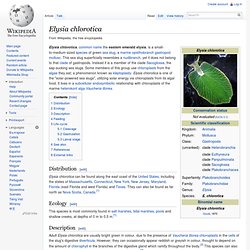
They can also be found as far north as Nova Scotia, Canada.[1] Ecology[edit] This species is most commonly found in salt marshes, tidal marshes, pools and shallow creeks, at depths of 0 m to 0.5 m.[1] Description[edit] Feeding[edit] The secret lives of sea lilies and feather stars. Once thought to be extinct, these lesser-known cousins of sea stars and sea urchins are some of the prettiest creatures in the ocean.

Prepare to be wowed, things are about to get weird (in a wonderful way). Beneath the surface of the sea is a world so vast that its mysteries are only slowly revealed to us … and when they are, they are often strange and beautiful beyond what we could previously imagine. Take the crinoids. These member of the echinoderm family are related to sea stars and sea urchins, but are far less famous. There are around 600 living species of these marine invertebrates, all marked by the same basic five-sided symmetry of their cousins – though they often have multiple arms that make the initial five sides hard to distinguish.
A crab eats the dead skin off a troop of marine iguanas. Microscopic Sea Creatures. By Daily Mail Reporter Updated: 16:31 GMT, 30 September 2010 Bobbing away in the dark depths of the ocean, these tiny creatures display a unique beauty that few get to truly appreciate.
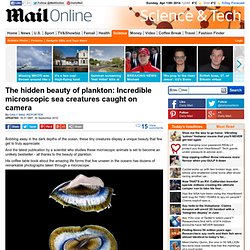
And the latest publication by a scientist who studies these microscopic animals is set to become an unlikely bestseller - all thanks to the beauty of plankton. Pacific Leaping Blenny. According to a new paper published in the journal Animal Behaviour, the Pacific leaping blenny (Alticus arnoldorum) – a unique fish that lives on land and can leap large distances – uses camouflage to avoid attacks by predators such as birds, lizards and crabs.
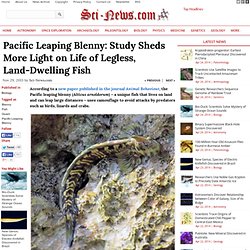
A Pacific leaping blenny at Taga’chang, Guam. Image credit: © Georgina Cooke, via Australian Museum. The Pacific leaping blenny is a 4 to 8-cm-long tropical fish found in reefs in Samoa and the Marianas, Society, and Cook Islands, in the western and southern Pacific Ocean. It remains on land all its adult life but has to stay moist to be able to breathe through its gills and skin.
Pacific leaping blennies move quickly over complex rocky surfaces using a unique tail-twisting behavior combined with expanded pectoral and tail fins that let them cling to almost any firm surface. Australian biologists from the University of New South Wales studied Pacific leaping blennies in their natural habitat on the tropical island of Guam. Puffer Fish Creates Ocean Floor ‘Crop Circles’ Evasive octopus who has been allowed to look for love. Visitors to the Portobello Aquarium loved Sid the octopus but all Sid wanted was to find a mate.
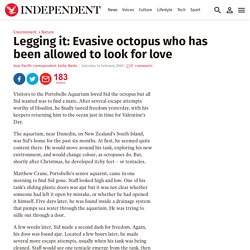
After several escape attempts worthy of Houdini, he finally tasted freedom yesterday, with his keepers returning him to the ocean just in time for Valentine's Day. The aquarium, near Dunedin, on New Zealand's South Island, was Sid's home for the past six months. Timelapse of swarming monster worms and sea stars. A Seahorse Inspects a Diver’s Watch. Jun 27, 2012 In this remarkable capture, a seahorse checks out a diver’s watch (and own reflection) underwater.
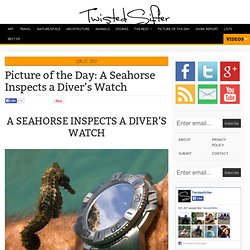
Given the clarity of the clouds in the reflection, this was likely taken quite close to the surface. Scientists accidentally kill world's oldest animal at age 507. The oldest animal ever known lived from 1499 until the day researchers cracked its shell open, killing it in the process.

Ming, an ocean quahog from the species Arctica islandica, was initially thought to be a record-setting 402 years old. Nemertea. Nemertea is a phylum of invertebrate animals also known as "ribbon worms" or "proboscis worms".[2] Alternative names for the phylum have included Nemertini, Nemertinea and Rhynchocoela.[1] Although most are less than 20 centimetres (7.9 in) long, one specimen has been estimated at 54 metres (177 ft).
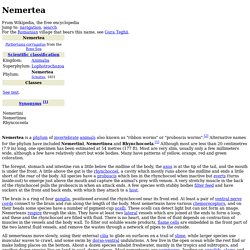
Most are very slim, usually only a few millimeters wide, although a few have relatively short but wide bodies. Many have patterns of yellow, orange, red and green coloration. How deep is the ocean, how high am I? How deep is the ocean, how high am I. via : Ghost Room.

Glaucus Atlanticus. Pharyngeal Jaws of Moray Eels. Portuguese Man o' War. "Gosh" you might say, "that's one weird looking jellyfish".

Well, you'd be partly right. Certainly it looks rather odd but it isn't a jellyfish, it isn't even one animal. The Portuguese Man o' War is in fact a whole colony of four different kinds of organism, each adapted to perform a specific function for the benefit of the whole. Lion fish amung silver.